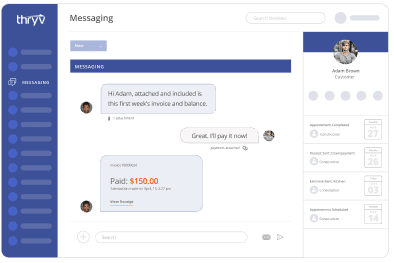Your business’s point of difference is what sets you apart from your competition. Consider it your competitive advantage. With many businesses selling similar products or services, identifying this unique selling point can be the key to success.
Here are 5 ways to define your point of difference.
What is Point of Difference Marketing?
Point of difference marketing means identifying a unique part of your product or service that differentiates you from other products in your industry. It could be a special feature, your pricing, or another factor that makes customer choose you over a competitor.
Free: Online Presence Scan
See how your business compares to the competition and find out what customers are saying about you.
Try NowPoint of difference marketing is important when you work in a competitive industry — like HVAC, plumbing, and home services. When other brands offer the same products or services as you, you need to find a way to make your business stand out.
Let’s take a look at some examples where point of difference marketing is used to promote products.
Examples of Point of Difference
Here are four examples of point of difference marketing. We’ll compare two brands with similar products but different marketing styles.
1. Paper Towels: Brawny vs. Reel
When you walk down the aisle of a grocery store, there are dozens of paper towel brands. They’re all selling the same product, but each one has their own point of difference.
For example, Brawny’s packaging mentions strength, power, and reliability often. Even its commercials have the tagline: “When life gets messy, Brawny helps you find strength.”
However, if we look at one of their competitors, Reel, we can see that this brand is taking a different approach. Reel sells “tree-free” bamboo paper towels. The point of difference is that they sell sustainable products that are eco-friendly and affordable.

Each brand advertises to a similar audience but highlights its product’s unique features to make the brand stand out.
2. Coffee: Dunkin’ vs. Starbucks
Dunkin’ and Starbucks have been rivals for quite some time. But, each brand appeals to a different type of coffee drinker.
Dunkin’ positions itself as a fast and efficient coffee shop. You get in, you get your coffee, and you go on your way. It’s that morning pitstop to fuel up for the workday. That’s why their motto is “America runs on Dunkin’.”

But Starbucks takes a different approach. It wants you to stay in its coffee shop, do some work, and relax while you have your coffee. The longer you stay in its cafe, the more likely you are to purchase something. That’s why Starbucks invests so much in its decor; they want you to spend more time in their stores.
3 Pet Food: Farmer’s Dog vs. Pedigree
Everyone loves their pets — and that’s why pet store marketing is so competitive. Pet owners don’t switch brands often, so it’s vital for pet brands to make their point of difference clear to their target audience.
One good example is the Farmer’s Dog, which sells dog food that’s safe for humans to eat (not that you would). Its marketing strategy revolves around nutrition and providing healthy meals to dogs of all ages. It stands out because other brands are not using the same ingredients as the Farmer’s Dog.

Pedigree, on the other hand, is a trusted brand because it focuses on the relationship you have with your pet. Its messaging highlights how you grow with your pet and the connection you make with them over time.

Both brands have an effective marketing strategy that demonstrates their value to their customers.
4. Plumbing: Roto-Rooter vs. Mr. Rooter
Plumbing is a competitive industry because every building has plumbing, and when the pipes don’t work, customers need solutions quickly. When you see water pouring from your sink onto your kitchen floor, you don’t care who fixes it; you just want it done now.
Roto-Rooter understands this feeling. Most of its marketing content focuses on emergency services. It advertises same-day bookings and coupons for last-minute projects. These deals make Roto-Rooter a top choice when it comes to emergency plumbing.

One of their top competitors, Mr. Rooter, takes a different approach. This brand focuses on reliability and being your trusted neighborhood plumber. They advertise quality, customer service, and other factors that build trust with customers.

Before we dive into how to use point of difference marketing, let’s review the various points of difference that you can use to promote your brand.
What are the Points of Difference for Marketing?
Here’s a list of ways you can differentiate your brand from others in your industry:
Price
Price is one of the most effective points of difference for small businesses. If you’re selling a similar product as your competitor, but at a cheaper price, you’ll stand out to most buyers. Price can also affect your customers’ perception of quality. If you sell the cheapest option, some people might not think your product will last. Alternatively, if you sell the most expensive option, you could be seen as a luxury item that not every person can afford.
Quality
Quality is another way to stand out from competitors. If you provide a top-of-the-line service or a product that’s built to last, customers will want to buy from you. Some people value quality over price because they believe they’ll save money by not making repeat purchases.
Features
When competing against similar brands, one thing you can focus on is your product’s unique features. Think about our paper towel example. Reel sells an eco-friendly towel that’s different from every other brand on the market. This feature makes their product memorable because it’s something that other companies don’t provide.
Impact
Some brands focus on the outcome of their product — in other words, how the product changes the customer’s life. Most medical brands do this by showing the before-and-after effects of using their product.
Perks
Perks are more prevalent with services. These are bonus features you get from working with a brand. For example, I chose my credit card company because one of its perks is cashback on all purchases. Loyalty programs, reward systems, and referral bonuses all fall under this category.

Modern Small
Business Playbook
Find expert tips and tools to help you streamline communications, automate your marketing efforts, improve your business operations, and more in this free guide.
Customer Service
Customer service is a powerful point of difference for any brand, big or small. If you provide excellent service, people will want to work with you. This will also lead to customer reviews, which help search engines like Google find you. When people search for “best X business near me,” they’ll see your company because you have a lot of good reviews.
Brand Values
Some people are loyal to brands because they align with their values. Patagonia is one company that customers are loyal to because it’s environmentally friendly. Social issues can also affect this point of difference. If a business supports certain causes, that can influence buying decisions.
Accessibility
Accessibility refers to how convenient it is to find and buy a product. When brands say they’re open 24/7, that’s a form of accessibility. Pharmacies are a great example of this. CVS offers a 24-hour pharmacy so customers can pick up prescriptions at all times.
Community
Some customers buy from brands because they want to be a part of a trend or group. Harley-Davidson is a great example. People buy Harleys because of the culture behind the brand. There are also motorcycle rallies and other events they can attend that are exclusive to Harley riders. Creating an exclusive customer group is a very effective way to get people interested in your business.
Delivery
Packaging and delivery can also affect how people interpret your brand. If your product stands out on a store shelf with bright colors and vibrant labeling, customers are more likely to notice you. Your packaging should reflect your brand’s tone and advertise directly to your ideal customer.
How to Use Point of Difference Marketing
Here’s how you can use point of difference marketing to make your business stand out.
1. Find out what keeps customers coming back.
Rather than scratching your head wondering what makes your business special, talk to the folks who keep doing business with you.
Ask your clients:
- What do they appreciate about your business?
- Why do your long-term customers keep coming back?
- What is the perceived value of your product or service?
The best way to get feedback is by asking for reviews. Positive reviews can help identify what differentiates you, while negative reviews can show you where improvements need to be made. It’s truly a win-win.
2. Find a problem, and solve It.
What are the common frustrations you hear from your clients? Often, finding a solution to a common problem or where there is a hole in the industry can be the point of difference you’re searching for.
Consider this:
Mike is a busy guy who likes to keep his house clean. He doesn’t have an issue keeping up with the vacuuming or dusting, but thanks to his dogs, the baseboards … well, they are always a mess. Unfortunately, he can’t find a cleaning service that will tackle the baseboards.
A cleaning service that offered extra deep cleaning, including baseboards and window wells would definitely get his business. And heck, he’d probably pay extra.
By identifying problems and evolving to solve them, your business can stand out against competitors stuck doing work the way it’s always been done.
3. Keep a keen eye on your competition.
Being aware of your competition is key. Understanding their point of difference makes it so that you aren’t promoting the exact same thing as them. You need to find the angle that shows off how you are different.
More importantly, you should also be keeping an eye on what your competition isn’t doing to help determine your business’ competitive advantage.
As mentioned in the last section, keeping an eye on the market offerings and what your clients are asking for is a great way to identify opportunities to differentiate.
4. Identify your niche.
It’s impossible to be everything to everyone. Rather, focus on a niche or an area where you can specialize.
By specializing in a specific customer niche, you can focus on the skills or services that uniquely benefit that customer. Being the best at delivering a specific solution to their unique situation enables you to maximize revenue and build stronger customer relationships.
Consider this:
Sarah’s hair needs a touch-up and this time she really wants to shake things up and dye her hair a nontraditional color. Lucky for Sarah, she’s found Kevin. Kevin specializes in trendy cuts and colors.
He’s identified his niche to be able to provide his clients an exceptional experience and dye-job that a stylist who focuses on traditional color may not be able to pull off. This is his point of difference and biggest selling point.
5. Make doing business with you easy.
One way to stand apart from your competition is by making it easy to do business with you. People like to follow the path of least resistance.
No matter how awesome a product or service is, your customers don’t want to feel like they are going through an obstacle course just to book an appointment.
Make it easy to book appointments online or leverage text messaging so they don’t have to pick up the phone to ask a question. Make payments a hassle-free process by accepting all forms of payments from credit cards to ACH.
Defining your unique point of difference might take a little time and some creativity, but once you’ve figured out what makes you special, you have a selling point that will help your business shine above the rest.

Modern Small
Business Playbook
Find expert tips and tools to help you streamline communications, automate your marketing efforts, improve your business operations, and more in this free guide.


